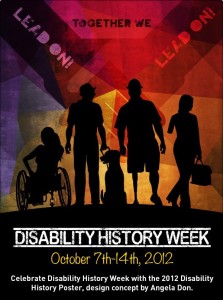Updated Post: Just How Far We Are From Equality: The San Diego Museum of Man’s Access/ABILITY Exhibit
I’ve updated this post after receiving an email and a comment from Grant Barrett, the Marketing Manager at the San Diego Museum of Man. Apparently, the disability exhibit is on the first floor and is fully accessible; moreover, the city of San Diego — not the museum — is responsible for the elevator repair. The second floor, which holds other exhibits, is not accessible at this time. Mr. Barrett writes:
Rachel, thanks so much for writing about the exhibit.
Unfortunately, you got an essential fact wrong: the access/ABILITY exhibit is totally accessible to people with disabilities. It’s on the first floor, and we have ramps and wide navigation paths everywhere we need them on that level.
We put the elevator notice on that page because we know that our disabled guests will want to see more than that one exhibit. The notice is also on the front page of the website and we announce it with signs at admissions.
The elevator repair, by the way, is beyond our control. The City of San Diego owns our buildings and maintains our elevators. We have no say as to when they will repair them or how long it will take. We’re hoping that the repairs will take much less time than predicted.
Thanks for being considerate of all of our visitors and keep up your good works.
In the light of Mr. Barrett’s email and comment, of course, I’ve corrected the post. My main points, however, still stand: any inaccessibility is a civil rights violation, and the presence of the exhibit itself reflects the basic segregation and inequality with which disabled people live.
—
I know that our society, by and large, does not yet see disability as a civil rights issue. I know that when people see stairs but no elevator, most of them don’t realize they’re looking at a civil rights violation. I know that most people don’t even blink when they see a sign that says that people with disabilities have to enter through the back door.
But every now and then, I’m surprised by how far behind the curve we are. Case in point: The San Diego Museum of Man has an exhibit called access/ABILITY in which you can allegedly “learn about how people with disabilities navigate the world!” (Exclamation point not mine.)
How does one become thus enlightened? Well, all you have to do is to “Learn phrases in American Sign Language, type your name in Braille, try a hand-pedaled bike and take part in a multi-sensory City Walk!” (Again, exclamation point not mine.) Because that’s what it takes to understand how disabled people live. Just go to a museum.
And of course, it is sure to “inspire.” It always, always has to “inspire.” Because really, that’s how disabled people navigate the world. Inspiringly.
And then — and hold on for this one — the exhibit is currently not accessible to people with disabilities.the entire second floor is inaccessible to people with disabilities. Yes: in a museum with an exhibit showing how disabled people “navigate the world,” disabled people cannot navigate up to the second floor to see any of the exhibits there. I’m not kidding. The website reads:
Our elevator will be out of service June 24 through August 2. If you require an elevator, you will be unable to visit the second floor exhibits. We apologize for the inconvenience.
Of course, these three sentences are not without irony. After all, they say more about how disabled people navigate the world than a museum exhibit ever could. Not only is the exhibit second floor inaccessible, but the lack of an elevator is described as an “inconvenience” rather than as a civil rights violation. For those just joining us, that’s like calling a sign that says, “No blacks or Jews allowed” an inconvenience rather than a civil rights violation.
The very existence of this kind of exhibit (are we still exotic animals to be exhibited?) speaks volumes about the inequality and social segregation of people with disabilities. Volumes. If we people with disabilities were actually integrated into society, people would have a pretty stellar notion of how we navigate the world. But when we’re set apart, we become curiosities.
As far as I’m concerned, this kind of exhibit is simply the 21st-century equivalent of a freak show. The fact that such things still exist is evidence of how very far we have to go.
© 2013 by Rachel Cohen-Rottenberg









Jules
6/29/2013 | 9:38 am Permalink
Oh. My. G-d.
Really. The fact that you can articulate anything about this shameful insensitivity/discrimination amazes me